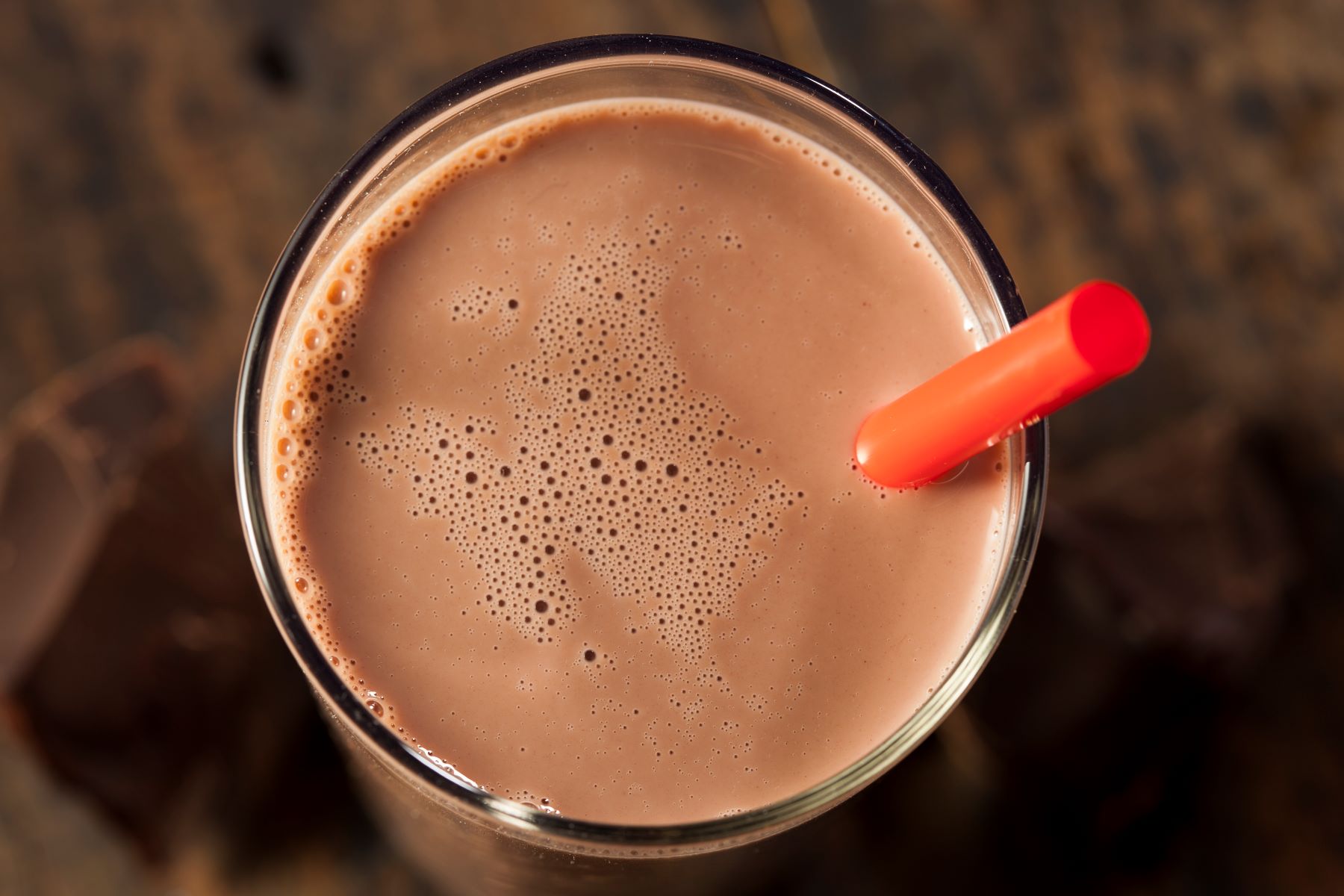

Featured
Why Drink Chocolate Milk After A Workout
Modified: August 19, 2023
"Discover the benefits of drinking chocolate milk after a workout. Our featured article explains why this delicious beverage is the ideal post-exercise recovery drink."
Introduction
When it comes to post-workout beverages, most people think of sports drinks or protein shakes. However, there is one surprising contender that can provide you with the necessary nutrients to aid in your recovery: chocolate milk. That’s right, the delicious drink that we all loved as kids can also be a beneficial choice for adults looking to optimize their post-workout nutrition.
But why chocolate milk? What makes it such a great option? Well, it turns out that chocolate milk offers a variety of benefits that can help replenish your body after a strenuous workout. Not only is it a tasty treat, but it also provides a winning combination of carbohydrates, protein, and electrolytes, making it an ideal choice for post-exercise recovery.
In this article, we will explore the many benefits of chocolate milk as a post-workout beverage and delve into its nutritional content. We will also compare chocolate milk to other popular post-workout drinks to help you understand why it stands out. Additionally, we will provide guidelines on how much chocolate milk you should consume and the best timing for optimal results. However, it’s worth noting that chocolate milk may not be suitable for everyone, so we will also discuss some precautions and considerations to keep in mind.
So, if you’re ready to discover the surprising benefits of chocolate milk and how it can contribute to your post-workout recovery, let’s dive in!
The Benefits of Chocolate Milk
Chocolate milk offers a wide range of benefits that can significantly enhance your post-workout recovery. Let’s take a closer look at some of its key advantages:
- Protein Replenishment: One of the primary benefits of chocolate milk is its protein content. Protein is essential for repairing and rebuilding muscle tissue after exercise. Chocolate milk contains whey and casein proteins, two high-quality protein sources that are easily digestible. Consuming protein-rich chocolate milk after a workout can help kickstart the muscle recovery process.
- Carbohydrate Refueling: Another important component of chocolate milk is its carbohydrate content. Carbohydrates are the body’s main source of energy, and they can become depleted during intense workouts. By consuming chocolate milk, you can replenish your glycogen stores and provide your body with the necessary fuel for future workouts.
- Electrolyte Balance: Sweating during exercise causes the loss of electrolytes, such as sodium and potassium. These electrolytes play a crucial role in maintaining proper hydration and muscle function. Chocolate milk contains a small amount of sodium and potassium, which can help restore electrolyte balance and prevent muscle cramps or fatigue.
- Hydration Support: Staying hydrated is vital for optimal athletic performance and recovery. While chocolate milk may not be as hydrating as plain water, it still provides a considerable amount of fluid. Additionally, the combination of carbohydrates and electrolytes in chocolate milk can enhance fluid absorption and retention, aiding in rehydration after a tough workout.
- Antioxidant Boost: Dark chocolate, which is often used to make chocolate milk, is rich in antioxidants. Antioxidants help to neutralize harmful free radicals produced during exercise, reducing inflammation and supporting overall recovery. By choosing higher cocoa content chocolate, you can maximize the antioxidant benefits of your post-workout beverage.
With these benefits in mind, it’s clear that chocolate milk provides a winning combination of nutrients that can effectively support your post-workout recovery. Next, let’s examine why chocolate milk specifically stands out as a preferred post-exercise drink compared to other popular options.
Chocolate Milk as a Post-Workout Drink
When it comes to choosing a post-workout drink, chocolate milk stands out as an excellent option for several reasons. Let’s explore why:
1. Muscle Recovery: Chocolate milk contains the perfect ratio of carbohydrates to protein, which research suggests is optimal for muscle recovery. The carbohydrates in chocolate milk replenish muscle glycogen stores, while the protein aids in muscle tissue repair and growth. This combination accelerates recovery and helps you get back to your training regimen faster.
2. Cost-Effective: Compared to specialized sports drinks or protein shakes, chocolate milk is a budget-friendly option. It offers similar benefits at a fraction of the cost. You can easily find chocolate milk at your local grocery store, making it accessible for anyone looking to enhance their post-workout recovery without breaking the bank.
3. Convenience: Another advantage of chocolate milk is its convenience. After a grueling workout, the last thing you want is to spend time preparing a complicated post-workout shake. With chocolate milk, you can grab a carton from the fridge and quickly replenish your body with the necessary nutrients. It’s a hassle-free and time-saving option for busy individuals.
4. Taste and Enjoyment: Let’s face it: consuming a post-workout beverage that you enjoy is important. Chocolate milk offers a delicious and satisfying flavor that can make the recovery process more enjoyable. Many athletes find the taste of chocolate milk to be a welcome reward after pushing their bodies to the limit during intense workout sessions.
5. Psychological Benefits: Drinking chocolate milk after a workout can have psychological benefits as well. It serves as a positive reinforcement, signaling the end of a tough training session and rewarding your hard work. This mental boost can contribute to your overall motivation and dedication to your fitness goals.
Overall, chocolate milk checks all the boxes as an ideal post-workout drink. It provides the necessary nutrients for muscle recovery, is cost-effective, convenient, enjoyable to consume, and can offer psychological benefits. However, it’s essential to understand the nutritional content of chocolate milk to ensure that you’re making an informed choice. Let’s delve into the specific nutritional components of chocolate milk in the next section.
The Nutritional Content of Chocolate Milk
Chocolate milk offers a unique blend of essential nutrients that make it an excellent choice for post-workout recovery. Let’s take a closer look at its nutritional content:
1. Carbohydrates: Chocolate milk is rich in carbohydrates, which are crucial for replenishing glycogen stores and providing energy for your body. A typical serving of chocolate milk (8 fluid ounces or 240 ml) contains around 26 grams of carbohydrates.
2. Protein: Protein is essential for muscle repair and growth. Chocolate milk contains both whey and casein proteins, which are considered high-quality protein sources. In an 8-ounce serving, you can expect to find approximately 8 grams of protein. While this may not be as high as some dedicated protein shakes, it is still a significant amount that can contribute to your recovery process.
3. Fat: Depending on the type of chocolate milk you choose, the fat content can vary. Whole milk chocolate milk contains more fat compared to low-fat or skim milk chocolate milk. However, it’s worth noting that the fat in chocolate milk provides added satiety and flavor. An 8-ounce serving of whole milk chocolate milk typically contains around 8 grams of fat.
4. Vitamins and Minerals: Chocolate milk is a good source of various vitamins and minerals. It contains essential nutrients like calcium, potassium, magnesium, and vitamins A and D. These nutrients play a vital role in supporting bone health, muscle function, and overall wellbeing.
5. Calories: Due to its carbohydrate and protein content, chocolate milk is not a calorie-dense beverage. An 8-ounce serving of chocolate milk typically ranges from 150 to 200 calories, depending on the fat content. It provides a moderate calorie intake that can support your post-workout recovery without causing a significant calorie surplus.
While the nutritional content of chocolate milk may vary slightly depending on the brand and type you choose, it generally offers a balanced combination of carbohydrates, protein, and essential vitamins and minerals. These nutrients work together to support your body’s recovery process after exercise. However, it’s important to consider how chocolate milk stacks up against other popular post-workout beverages. Let’s compare chocolate milk to some common options in the next section.
Chocolate Milk vs. Other Post-Workout Beverages
When it comes to post-workout beverages, there are several options available. Let’s compare chocolate milk to some other popular choices:
1. Sports Drinks: Sports drinks are designed to replenish electrolytes and provide quick energy during intense exercise. While they can be beneficial during prolonged and high-intensity workouts, they typically contain higher levels of added sugars and fewer essential nutrients compared to chocolate milk. Chocolate milk offers a better balance of carbohydrates, protein, and electrolytes, making it a more well-rounded choice for overall post-workout recovery.
2. Protein Shakes: Protein shakes are often consumed by fitness enthusiasts to meet their protein needs after workouts. While they can provide a higher concentration of protein, chocolate milk offers a good amount of protein along with carbohydrates, which are equally important for post-workout recovery. Additionally, chocolate milk tends to be more affordable and readily available compared to protein shakes, making it a convenient choice for many individuals.
3. Plain Milk: Milk, in general, is a great source of nutrients, including protein and calcium. However, chocolate milk has the added benefit of carbohydrates and a delicious flavor. While both plain milk and chocolate milk can contribute to post-workout recovery, chocolate milk can provide a better combination of nutrients for muscle repair and glycogen replenishment.
4. Water: Staying hydrated is essential during and after workouts. While water is the go-to choice for hydration, it lacks the additional nutrients found in chocolate milk. Plain water is primarily important for restoring fluid balance, while chocolate milk offers a comprehensive package of carbohydrates, protein, and electrolytes, making it a more beneficial choice for recovery.
Overall, chocolate milk compares favorably to other post-workout beverages. Its unique combination of carbohydrates, protein, and electrolytes, along with its affordability and great taste, make it an excellent choice for those seeking an effective and enjoyable way to recover after exercise.
Now that we understand the benefits and nutritional value of chocolate milk, let’s explore how much you should consume and the optimal timing for post-workout consumption in the next section.
How Much Chocolate Milk Should You Consume?
The amount of chocolate milk you should consume after a workout depends on various factors, including your body weight, exercise intensity, and duration. However, here are some general guidelines:
1. Consider Protein Intake: To support muscle recovery, it’s recommended to consume around 20-30 grams of protein after a workout. Since chocolate milk contains approximately 8 grams of protein per 8-ounce serving, you may need to supplement it with additional protein sources if you require a higher protein intake.
2. Calculate Carbohydrate Needs: The recommended carbohydrate intake after exercise is typically around 0.8-1.2 grams per kilogram of body weight. For example, if you weigh 70 kilograms, you may want to consume 56-84 grams of carbohydrates. Keep in mind that an 8-ounce serving of chocolate milk contains roughly 26 grams of carbohydrates.
3. Hydration Considerations: Remember that staying hydrated is essential for optimal recovery. While chocolate milk provides some fluid, it’s important to also hydrate with water or electrolyte-rich beverages, especially if you have engaged in a particularly intense or prolonged workout that resulted in significant fluid loss through sweat.
4. Listen to Your Body: Ultimately, it’s important to listen to your body and adjust your chocolate milk intake based on your individual needs and preferences. Some athletes may find that a single serving of chocolate milk is sufficient, while others may benefit from consuming more for better recovery. Pay attention to how your body feels and adjust your consumption accordingly.
Keep in mind that while chocolate milk is a delicious and nutritious post-workout option, it should be consumed as part of a balanced diet. It’s important to incorporate other whole foods, such as fruits, vegetables, lean proteins, and whole grains, into your overall nutrition plan to meet your body’s needs.
Now that we’ve explored how much chocolate milk you should consume, let’s discuss the best time to enjoy this tasty treat after your workouts.
Best Time to Consume Chocolate Milk After a Workout
The timing of consuming chocolate milk after a workout can influence its effectiveness in aiding recovery. Here are some key considerations for determining the best time to enjoy your post-workout chocolate milk:
1. Immediately after your workout: Consuming chocolate milk within 30 minutes to an hour after your workout is often recommended. During this time frame, your body is primed to uptake nutrients and replenish glycogen stores more efficiently. Drinking chocolate milk at this time can provide a quick source of carbohydrates and protein to kickstart the recovery process.
2. Pre-Workout Hydration: It’s essential to ensure that you are adequately hydrated before your workout. While chocolate milk can provide some fluid, it’s beneficial to drink water or an electrolyte-rich beverage prior to your workout to prevent dehydration and maintain optimal performance.
3. Post-Workout Meal Considerations: If you plan to have a full meal after your workout, you can still include chocolate milk as part of your post-workout nutrition strategy. Enjoying chocolate milk as a snack or alongside a balanced meal can provide an additional source of nutrients without overpowering your overall caloric intake.
4. Individual Preferences and Schedule: Ultimately, the best time to consume chocolate milk after a workout depends on your schedule and personal preferences. Some individuals may prefer to have it immediately after their workout, while others may choose to drink it as a mid-morning or mid-afternoon snack. The most important aspect is to ensure that you incorporate it into your post-workout routine in a way that aligns with your needs and preferences.
Remember that consistency is key. Whether you choose to enjoy your chocolate milk immediately post-workout or at another time, aim to make it a regular part of your routine to support your body’s recovery and replenishment needs.
Now, before you grab that delicious glass of chocolate milk, let’s discuss some precautions and considerations to keep in mind.
Precautions and Considerations
While chocolate milk has numerous benefits as a post-workout beverage, there are a few precautions and considerations to keep in mind:
1. Allergies or Dietary Restrictions: Chocolate milk often contains dairy products, so individuals with lactose intolerance or dairy allergies should choose dairy-free alternatives or consult with a healthcare professional before consuming chocolate milk.
2. Added Sugar Content: Some commercially available chocolate milk products may contain significant amounts of added sugars. It’s important to check the label and choose options that have lower sugar content or opt for homemade chocolate milk made with higher cocoa content dark chocolate or cocoa powder.
3. Individual Nutritional Needs: While chocolate milk provides a balanced combination of carbohydrates, protein, and electrolytes, everyone’s nutritional needs and goals may vary. It’s important to consider your specific goals, dietary restrictions, and consult with a registered dietitian or healthcare professional if needed.
4. Caloric Intake: While chocolate milk can help replenish your body after a workout, it’s essential to consider its caloric content and integrate it into your overall caloric intake for the day. This is particularly important for individuals who are watching their weight or have specific dietary goals.
5. Personal Digestion and Tolerance: Each individual may have different digestive responses to chocolate milk. It’s important to be aware of your own tolerance and any gastrointestinal issues that may arise after consuming chocolate milk. Adjust your portion size or opt for lactose-free alternatives if necessary.
By being mindful of these precautions and considerations and understanding your own body’s needs, you can responsibly incorporate chocolate milk into your post-workout routine for optimal results.
Now that we have explored the precautions and considerations, let’s conclude our discussion on the surprising benefits of chocolate milk as a post-workout beverage.
Conclusion
Chocolate milk is not only a nostalgic childhood favorite but also a surprisingly effective post-workout beverage. Its combination of carbohydrates, protein, electrolytes, and other essential nutrients offers numerous benefits for muscle recovery, hydration, and overall well-being.
Throughout this article, we explored the benefits of chocolate milk as a post-workout drink, including its ability to replenish glycogen stores, provide protein for muscle repair, restore electrolyte balance, support hydration, and offer an antioxidant boost. We compared chocolate milk to other popular post-workout beverages and highlighted its cost-effectiveness, convenience, and taste as standout qualities.
We discussed how the nutritional content of chocolate milk, including carbohydrates, protein, fat, vitamins, and minerals, contributes to its effectiveness as a post-workout beverage. We also provided guidelines on the amount of chocolate milk to consume based on protein and carbohydrate needs, emphasizing the importance of listening to your body’s cues.
We further explored the best time to consume chocolate milk after a workout, suggesting immediate post-workout consumption or incorporating it into a balanced meal or snack. We also highlighted precautions related to allergies, added sugar content, individual nutritional needs, caloric intake, and personal digestion and tolerance.
In conclusion, chocolate milk is a delicious and beneficial post-workout drink that can contribute to your body’s recovery and replenishment needs. It offers a convenient and cost-effective option compared to specialized sports drinks or protein shakes. However, it’s important to consider your own individual needs and dietary goals, and consult with a healthcare professional if necessary.
So why not indulge in a glass of chocolate milk after your next workout? It’s a treat for your taste buds and a boost for your body’s recovery process. Cheers to the surprising benefits of chocolate milk!









